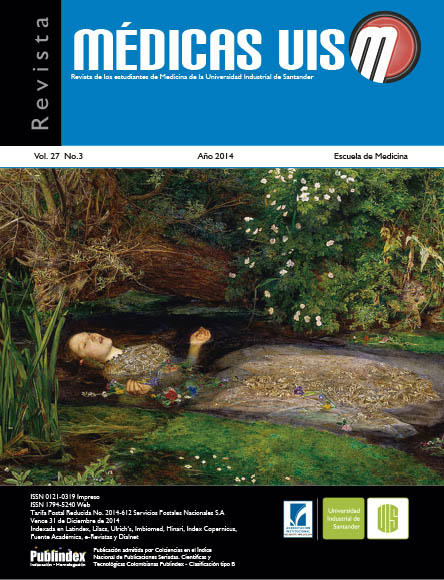Abstract
Introduction: Reye’s syndrome is an acute encephalopathy associated with fatty degeneration of the liver that usually is preceded by a respiratory infection or chickenpox and is highly prevalent in children under 6 years old. Objective: to report a clinical case of congenital Reye’s syndrome associated with varicella infection acquired from the mother. Case report: we describe the autopsy findings with the respective clinicopathological correlation of a male newborn of 37 weeks of gestation, son of mother with active varicella from 4 days before birth, who presented sudden paleness, bradycardia and apnea. Results: histopathologic examination found in the cytoplasm of hepatocytes and renal tubules a vacuolar commitment that corresponds to fat. The brain showed severe edema without perivascular or meningeal inflammation. Discussion and conclusion: it corresponds a case of congenital Reye’s syndrome associated with varicella infection in pregnancy, who finished clinically as sudden death. This could be the first published case of congenital Reye’s syndrome associated with varicella infection in pregnancy. MÉD.UIS. 2014;27(3):113-121.
References
2. Balistreri WF. Reye syndrome and “reye - like” diseases. In: Behrman RE, Kliegman RM, Arvin AM, editors. Nelson Textbook of Pediatrics. 15th ed. Philadelphia: W.B. Saunders Company; 1996. p 1144-5.
3. McGovern M, Glasgow J, Stewart M. Lesson of the week: Reye’s syndrome and aspirin: lest we forget. BMJ. 2001;322:1591-2.
4. Hurwitz ES, Nelson DB, Davis C, Morens D, Schonberger LB. National surveillance for Reye syndrome: A five year review. Pediatrics. 1982;70:895.
5. Trauner DA. Reye’s syndrome [Medical Progress]. West J Med. 1984;141:206-9.
6. Lovejoy FH Jr, Smith AL, Bresnan MJ, Wood JN, Victor DI, Adams PC. Clinical Staging in Reye Syndrome. Am J Dis Child. 1974;128(1):36-41.
7. Huttenlocher PR, Trauner DA. Reye’s syndrome in infancy. Pediatrics. 1978;62(1):84-90.
8. Belay ED, Bresee JS, Holman RC, Khan AS, Shahriari A, Schonberger LB. Reye’s syndrome in the United States from 1981 through 1997. N Engl J Med. 1999;340(18):1377-82.
9. Baldellou A. Síndrome de Reye. Cuarenta años después. An Pediatr (Barc). 2003;59(4):319-22.
10. Daugherty CC. A morphometric study of Reye’s Syndrome. Am J Path. 1987;129:313-6.
11. Weiner DL. Reye síndrome: http://emedicine.medscape.com/ article/803683-overview
12. Benítez L, Pretelt F, Morillo L. Síndrome de Reye: Informe de un caso en adultos. Acta Medica Colombiana. 1992;17(1):63-7.
13. Casteels-Van Daele M, Van Geet C, Wouters C, Eggermont E. Reye syndrome revisited: a descriptive term covering a group of heterogeneous disorders. Eur J Pediatr. 2000;159(9):641-8.
14. Castillo F. Ácido acetilsalicílico y síndrome de Reye. Offarm 2003;22(9):167.
15. Prandota J. Important role of prodromal viral infections responsible for inhibition of xenobiotic metabolizing enzymes in the pathomechanism of idiopathic Reye’s syndrome, Stevens-Johnson syndrome, autoimmune hepatitis, and hepatotoxicity of the therapeutic doses of acetaminophen used in genetically predisposed persons. Am J Ther. 2002;9(2):149-56.
16. Schrör K. Aspirin and Reye Syndrome A Review of the Evidence. Pediatr Drugs. 2007;9(3):195-204.
17. Reye syndrome-insights on causation and prognosis. Arch Dis Child. 2001;85:351-3.
18. Mowat AP. Reye’s syndrome and aspirin. In: Vane JR, Botting RM, editors. Aspirin and other salicylates. London: Chapman & Hall Medical. 1992:531-47.
19. Corey L, Rubin RJ, Hattwick MAW, Noble GR, Cassidy E. A nationwide outbreak of Reye’s syndrome: its epidemiologic relationship to influenza B. Am J Med. 1976;61:615-25.
20. Starko KM, Ray CG, Dominguez LB, Stromberg WL, Woodall DF. Reye’s syndrome and salicylate use. Pediatrics. 1980;66:859-64.
21. Waldman RJ, Hall WN, McGee H, Van Amburg G. Aspirin as a risk factor in Reye’s syndrome. JAMA . 1982;247:3089-94.
22. Hurwitz ES, Barrett MJ, Bregman D, Gunn WJ, Schonberger LB, Fairweather WR, et al. Public Health Service study of Reye’s syndrome and medications: report of the main study. JAMA. 1987;257:1905-11.
23. Duerksen D, Jewell L, Mason A, Bain V. Co-existence of hepatitis A and adult Reye’s. Gut. 1997;41:121-4.
24. Stumpf DA. Reye syndrome: an international perspectiva. Brain & Development. 1995;17(suppI):77-8.
25. Felipo V, Butterworth R. Mitochondrial dysfunction in acute hyperammonemia. Neurochemistry International. 2002;40:487-91.
26. American Academy of Pediatrics. Varicella-zoster Infections. In: Pickering LK, Baker CJ, Long SS, Kimberlin DW, editors. Red Book: 2012 Report of the Committee on Infectious Diseases. 29th ed. Elk Grove Village: American Academy of Pediatrics; 2012. p.774–89.
27. CDC. Reye Syndrome 1990 Case Definition: wwwn.cdc.gov/nndss/script/casedef.aspx?condyrid=821&datepub=1/1/1990%2012:00:00%20am.
28. Papageorgiou A, Wiglesworth FW, Schiff D, Stern L. Reye’s syndrome in a newborn infant. Can Med Assoc J. 1973;109(8):717-20.
29. National Reye’s Syndrome Foundation. What is Reye’s Syndrome?: http://www.reyessyndrome.org/what.html
30. Quintillá J, Campistol J, Boleda M, Vilaseca M, Artuch R, Palomeque A, et al. Síndrome de Reye-like como manifestación inicial de enfermedad mitocondrial. An Esp Pediatr. 2000;52:479-82.
31. Burton B. Inborn Errors of Metabolism in Infancy: A Guide to Diagnosis. Pediatrics. 1998;102:69.
32. Corrigan J, Watkins L. Hemorrhagic chickenpox associated with disseminated intravascular coagulation. Pediatric Research 1971;5:404–5.
33. American Academy of Pediatrics. Passive immunization. In: Pickering LK, Baker CJ, Long SS, McMillan JA, editors. Red Book: 2012 Report of the Committee on Infectious Diseases. 29th ed. Elk Grove Village: American Academy of Pediatrics; 2012. p.56-69.
34. Ohlsson A, Lacy J. Intravenous immunoglobulin for suspected or subsequently proven infection in neonates. Cochrane Database Syst Rev. 2010;17(3):CD001239.
35. Ohlsson A, Lacy JB. Intravenous immunoglobulin for preventing infection in preterm and/or low-birth-weight infants. Cochrane Database Syst Rev. 2004;(1):CD000361.
36. Cardona R, Montoya F, Orrego JC. Anafilaxia. Iatreia. 2000;13(1): 16-31.
37. Shearer W, Fleisher T. Constituyent and Development of the Inmune System. In: Middleton E, editors. Alergy: principIes and practice. 5th ed. St Louis: Mosby; 1998. p.2-8.
38. Gold Y, Golderg A, Sivan Y. Hyper-releasability of mast cells in family members of infants with sudden infant death syndrome and apparent life-threatening events. J Pediatr. 2000;136(4):460-5.
39. Weber MA, Ashworth MT, Risdon RA, Brooke I, Malone M, Sebire NJ. Sudden unexpected neonatal death in the first week of life: autopsy findings from a specialist centre. J Matern Fetal Neonatal Med. 2009;22(5):398-404.
